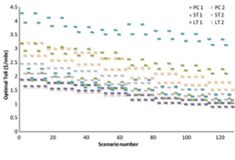
P.I.:
Mecit Cetin
Old Dominion University
Year:
2014
Project Report:
NTC 2014 Information Form_Principal Investigator_Mecit Cetin_tolls_September 2014.pdf
NTC 2015 Information Form_Principal Investigator_Mecit Cetin_tolls_March 2015.pdf
NTC2014-SU-R-15 Mecit Cetin.pdf
Subject Area:
Basic Research
Description:
The impetus for fully connected vehicles is strong and growing. Future vehicles are expected to have full connectivity and environmental awareness with access to the essential system-state information in real-time. A large and growing body of research on understanding the safety and mobility implications of connected vehicles already exists. However, there is no significant work on investigating new pricing/tolling options in a connected vehicles world. Congestion pricing is an effective method to address the growing congestion problems on freeways. In the current state of practice, toll lanes are typically separated from the regular lanes (with physical barriers) with toll rates either fixed or varying by time-of-day or traffic congestion. Information from vehicles that sense their own locations (including the lanes they are in) and exchange information about their positions and speeds can be used to develop and support an open tolling system with the number of “tolled lanes” varying dynamically to maximize throughput. Vehicle displays would inform drivers about the prevailing toll rates and designated tolled lanes. The number of lanes dedicated to toll lanes can be optimized based on various policies that are best suited for the given conditions. This flexibility to allocate and manage the scarce road capacity, and the differential pricing options enabled by the connected vehicles can ultimately translate into a more efficient and economically sustainable transportation network. We propose to build various models (e.g., agent-based models) to investigate the best toll policies and traffic control options in a connected vehicles environment. Therefore, the main objectives of this project include: • Developing a framework for a tolling system in a connected vehicle environment • Developing an algorithm (or algorithms) to optimize tolls and the number of toll lanes dynamically under different traffic conditions • Evaluate how such a system will perform and operate in a simulation environment.
Top